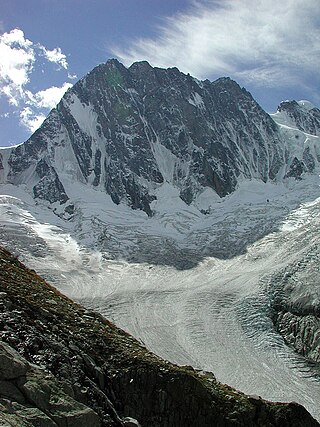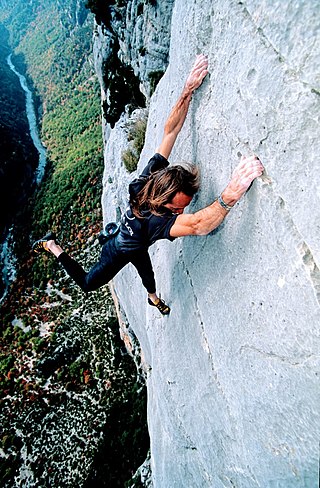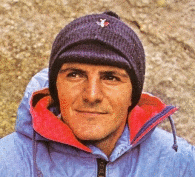
The Matterhorn is a mountain of the Alps, straddling the main watershed and border between Italy and Switzerland. It is a large, near-symmetric pyramidal peak in the extended Monte Rosa area of the Pennine Alps, whose summit is 4,478 metres (14,692 ft) above sea level, making it one of the highest summits in the Alps and Europe. The four steep faces, rising above the surrounding glaciers, face the four compass points and are split by the Hörnli, Furggen, Leone/Lion, and Zmutt ridges. The mountain overlooks the Swiss town of Zermatt, in the canton of Valais, to the northeast; and the Italian town of Breuil-Cervinia in the Aosta Valley to the south. Just east of the Matterhorn is Theodul Pass, the main passage between the two valleys on its north and south sides, which has been a trade route since the Roman Era.

In mountaineering and climbing, a first ascent, is the first successful documented climb to the top of a mountain or the top of a particular climbing route. Early 20th-century mountaineers and climbers were focused on reaching the tops of iconic mountains and climbing routes by whatever means possible, often using considerable amounts of aid climbing, and/or with large expedition style support teams that laid "siege" to the climb.

The Eiger is a 3,967-metre (13,015 ft) mountain of the Bernese Alps, overlooking Grindelwald and Lauterbrunnen in the Bernese Oberland of Switzerland, just north of the main watershed and border with Valais. It is the easternmost peak of a ridge crest that extends across the Mönch to the Jungfrau at 4,158 m (13,642 ft), constituting one of the most emblematic sights of the Swiss Alps. While the northern side of the mountain rises more than 3,000 m (10,000 ft) above the two valleys of Grindelwald and Lauterbrunnen, the southern side faces the large glaciers of the Jungfrau-Aletsch area, the most glaciated region in the Alps. The most notable feature of the Eiger is its nearly 1,800-metre-high (5,900 ft) north face of rock and ice, named Eiger-Nordwand, Eigerwand or just Nordwand, which is the biggest north face in the Alps. This huge face towers over the resort of Kleine Scheidegg at its base, on the eponymous pass connecting the two valleys.

The Grandes Jorasses is a mountain in the Mont Blanc massif, on the boundary between Haute-Savoie in France and Aosta Valley in Italy.

Free solo climbing, or free soloing, is a form of rock climbing where the climbers climb solo without ropes or other protective equipment, using only their climbing shoes and their climbing chalk. Free soloing is the most dangerous form of climbing, and, unlike bouldering, free soloists climb above safe heights, where a fall can be fatal. Though many climbers have free soloed climbing grades they are very comfortable on, only a tiny group free solo regularly, and at grades closer to the limit of their abilities.

Walter Bonatti was an Italian mountaineer, alpinist, explorer and journalist. He was noted for many climbing achievements, including a solo climb of a new alpine climbing route on the south-west pillar of the Aiguille du Dru in August 1955, the first ascent of Gasherbrum IV in 1958, and, in 1965, the first solo climb in winter of the North face of the Matterhorn on the mountain's centenary year of its first ascent. Immediately after his solo climb on the Matterhorn, Bonatti announced his retirement from professional climbing at the age of 35, and after 17 years of climbing activity. He authored many mountaineering books and spent the remainder of his career travelling off the beaten track as a reporter for the Italian magazine Epoca. He died on 13 September 2011 of pancreatic cancer in Rome aged 81, and was survived by his life partner, the actress Rossana Podestà.
Andreas "Anderl" Heckmair was a German mountain climber and guide who led the first successful ascent of the Eiger north face in July 1938.

The six great north faces of the Alps are a group of vertical faces in the Swiss, French, and Italian Alps known in mountaineering for their difficulty, danger, and great height. The "Trilogy" is the three hardest of these north faces, being the Eiger, the Grandes Jorasses, and the Matterhorn.

In mountaineering and climbing, enchainment is climbing two or more mountains or climbing routes on a mountain in one outing. Rock climbing two or more routes in this manner are also called a "link up" in the United States. Climbers may do an enchainment of easy routes as a way of training for a more difficult objective, but some enchainments of hard routes are a prize in their own right, a notable example being the great north faces of the Alps.

Ivano Ghirardini is a French mountaineer.

Jean Troillet is a professional mountain climber.
Catherine Destivelle is a French rock climber and mountaineer who is considered one of the greatest and most important female climbers in the history of the sport. She came to prominence in the mid-1980s for sport climbing by winning the first major female climbing competitions, and by being the first-ever female to redpoint a 7c+/8a sport climbing route with Fleur de Rocaille in 1985, and an 8a+ (5.13c) route with Choucas in 1988. During this period, she was considered the strongest female sport climber in the world along with Lynn Hill, however, in 1990 she retired to focus on alpine climbing.

Ueli Steck was a Swiss rock climber and alpinist. He was the first to climb Annapurna solo via its South Face, and set speed records on the North Face trilogy in the Alps. He won two Piolet d'Or awards, in 2009 and 2014. Having previously summitted Mount Everest, Steck died on 30 April 2017 after falling during an acclimatizing climb for an attempt on the Hornbein route on the West Ridge of Everest without supplemental oxygen.
Tsuneo Hasegawa was a Japanese alpinist. His achievements include the winter solo ascent of the "Great North Faces of the Alps" or "North Face Trilogy" and the world's first winter solo ascent of the South Face of Aconcagua in 1981. He died in 1991 in an avalanche while ascending the Ultar II South east face.

Alpine climbing is a type of mountaineering that involves using any of a broad range of advanced climbing skills, including rock climbing, ice climbing, and/or mixed climbing, to summit typically large routes in an alpine environment. While alpine climbing began in the European Alps, it is used to refer to climbing in any remote mountainous area, including in the Himalayas and in Patagonia. The derived term alpine style refers to the fashion of alpine climbing to be in small lightly-equipped teams who carry all of their own equipment, and do all of the climbing.

The Mount Everest climbing season of 2017 began in spring with the first climbers reaching the top on May 11, from the north side. The first team on the south side reached the top on May 15. By early June, reports from Nepal indicated that 445 people had made it to the summit from the Nepali side. Reports indicate 160–200 summits on the north side, with 600–660 summiters overall for early 2017. This year had a roughly 50% success rate on that side for visiting climbers, which was down from other years. By 2018, the figure for the number of summiters of Everest was refined to 648. This includes 449 which summited via Nepal and 120 from Chinese Tibet.
The recorded history of climbing of the Eiger mountain in Switzerland starts in the 1800s. It is split between the pre-north face era, when the main summits and easier ridges and faces were climbed, and the post-north face era, when it became one of the greatest prizes in mountaineering. At least sixty-four climbers have died while attempting the ascent.
Kacper Tekieli was a Polish mountain climber and sport climbing instructor with a title given by the Polish Alpinism Association. His accomplishments in mountaineering include ascents of the Tatra Mountains, Mount Elbrus, Makalu, Broad Peak, and the Alps. He died in an Jungfrau avalanche in the village of Stechelberg in 2023.












